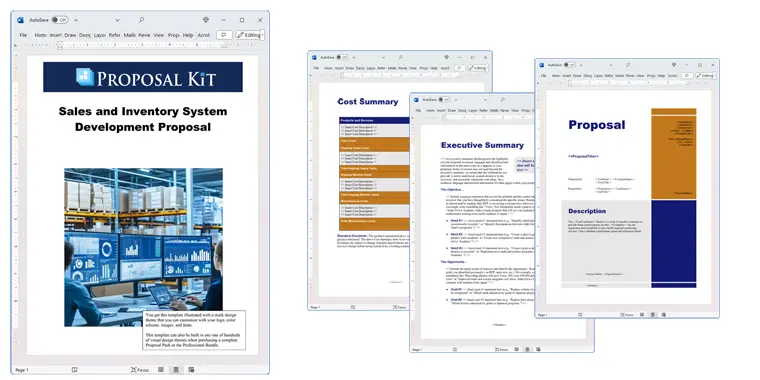How to write your Sales and Inventory System Development Proposal
We include this 29 page layout with every Proposal Pack. If you want this template to have a different visual design theme than the one illustrated here, purchase any Proposal Pack design and create this template using the purchased design theme. This template is included in every Proposal Pack. If you get a Proposal Pack or the Professional, you can also make any variation of this template with different chapters to suit your needs.
We typically include more chapters in the templates than most people will need to give everyone more variety in the chapters they may need. You can trim down a long template by removing pages you do not need or combining multiple chapter topics into one page.
 DOWNLOADABLE, ONE-TIME COST, NO SUBSCRIPTION FEES
DOWNLOADABLE, ONE-TIME COST, NO SUBSCRIPTION FEESYou can also create countless variations of this document to suit your needs using the included library of 2200+ chapters if ordering a Proposal Pack or Professional.
 What Our Clients Say
What Our Clients SayI have been using the Proposal Pack since 2013. It has a lot of resources to writing the right proposal in a neat fast pace thanks to the Wizard included. The user interface was simple to use from the start. Definitely a great product that has gotten better over time. They are always improving and offers a very nice title pages packs to make each of your proposals unique. It is super easy to use, and very professional looking end result. I would recommend it to anyone."
BETA Financial Ltd
Related Article
Related Video
Related Templates
- Inventory Management Project Proposal
- Software Installation and Training Proposal
- Technology Strategy Analysis
- Software Beta Testing Project Proposal
- Software System Testing Project Proposal
- Software Automation Proposal
- Software and Hardware System Proposal
- Software as a Service (SAAS) Proposal
- Custom Software Development Proposal
- Managed Services IT Proposal
- Inventory Management Proposal Template
- EMV Chip and Pin Migration Proposal
- Procurement and Consignment Services Proposal
- Software Licensing Sales Proposal
- BANT Sales Proposal Template
- FinTech System Integration Proposal Template
- FinTech Managed Services Sales Proposal Template
- Training Services for Software Proposal
- Sales Quota Improvement Proposal
What's the Best Way to Write Your Sales and Inventory System Development Proposal?
Using the Proposal Kit template library and Wizard software package is a proven solution. This robust tool not only simplifies the proposal writing process but also incorporates a powerful line item quoting database system for cost summaries, quotes, estimates, budgets, and financial discussions.
Are you tasked with creating a proposal for sales and inventory system development? Proposal Kit is designed for you.
What Types of Projects Are Sales and Inventory System Development Proposals Written For?
Proposals for sales and inventory system development are typically required for a diverse range of projects. These projects often necessitate a detailed and tailored plan to ensure success. Here are some examples of such projects:
- Enhancing existing inventory management systems
- Implementing a new sales tracking system
- Developing a custom software solution for retail management
- Integrating inventory software with e-commerce platforms
- Automating inventory restocking processes
- Creating a centralized inventory database for multi-location businesses
- Setting up a sales analytics dashboard
- Developing a mobile app for inventory management
- Improving warehouse management systems
- Establishing a cloud-based inventory solution
- Customizing point-of-sale systems
- Developing a purchase order management software
- Integrating CRM with inventory systems
- Designing a barcode scanning system
- Streamlining inventory supply chain processes
- Upgrading outdated sales tracking software
- Implementing RFID technology for inventory control
- Developing software for inventory forecasting
- Building a reporting tool for sales and inventory data
- Creating a user-friendly interface for inventory management
Chapters this template is built with
There is no one-size-fits-all template for writing an inventory system development proposal. However, Proposal Kit's software and content library lets you create custom variations that cover all potential situations. With access to thousands of templates, users can tailor their proposals to address specific needs. The following is a sample list of chapters that can be customized using Proposal Kit's extensive library:
Cover Letter
The Cover Letter introduces the proposal, highlighting the purpose and expected outcomes of the project. It sets the stage for the proposal and establishes a connection with the recipient. In an inventory system development proposal, the cover letter might specifically address how the new system will revolutionize the client's inventory processes, making operations smoother and more profitable.
Executive Summary
An Executive Summary provides a concise overview of the proposal, summarizing key points such as project objectives, anticipated benefits, and overall approach. For a sales and inventory management proposal, this section would briefly outline the main goals, such as reducing stock discrepancies and increasing sales efficiency, giving stakeholders a snapshot of the potential impact.
Cost Summary
The Cost Summary outlines the financial topics of the project, providing a detailed breakdown of estimated costs. This chapter is crucial in a sales and inventory proposal, as it offers transparency on investments required for software development, hardware upgrades, and potential cost savings from improved inventory management.
Needs Assessment
The Needs Assessment chapter identifies the specific requirements of the organization. It demonstrates an understanding of the current challenges and how the proposed solution will address them. In this context, it might elaborate on existing inventory inefficiencies and how a new system will remedy these issues, enhancing order fulfillment and inventory accuracy.
Benefits
This section highlights the anticipated benefits of implementing the proposed system, emphasizing how it will improve efficiency, accuracy, and overall business operations. For instance, it could discuss how the system will enable real-time inventory tracking and seamless integration with sales platforms, thus boosting operational efficiency.
Features
In the Features section, the specific functionalities and capabilities of the proposed system are described, providing a comprehensive understanding of its potential impact. The proposal might highlight features like automated stock level alerts, sales forecasting tools, and comprehensive reporting functionalities.
Solutions
The Solutions chapter offers a detailed explanation of how the proposed system will resolve the identified issues, showcasing the approach and methodology to be used. This might include integrating the software with existing systems or implementing cloud-based solutions for enhanced accessibility and scalability.
Life Cycle
This section outlines the expected life cycle of the software solution, including development, deployment, and maintenance phases. In a sales and inventory context, it would detail timelines and phases for initial deployment, user training, and ongoing maintenance to ensure the system remains effective long-term.
Asset Management
Asset Management details how the proposed system will help track and manage company assets, optimizing their use and ensuring cost-effectiveness. It could elaborate on features like asset tracking through barcodes or RFID and how this will minimize losses and improve asset utilization.
Records Management
In this chapter, the focus is on how the system will manage records, ensuring data integrity, security, and accessibility. It might specifically address how the system will store transaction records and inventory logs to allow for easy retrieval and audit compliance.
Methodology
The Methodology section explains the approach and processes to be adopted during project execution, ensuring structured and efficient implementation. For a sales and inventory project, this could include agile development processes or phased rollouts to minimize disruption.
Project Background
This chapter provides context by detailing the history and background of the project, helping stakeholders understand its importance. It might discuss past inventory challenges and the impetus for seeking a more sophisticated management solution.
Project Management
The Project Management section outlines the project management strategies and tools that will be used to keep the project on track. This may include project timelines, key milestones, and the use of management software to track progress and ensure timely delivery.
Installation Schedule
Here, a detailed installation schedule is provided, ensuring stakeholders are aware of the key milestones and timelines. It would specify installation phases, testing periods, and go-live dates for various system components in the sales and inventory environment.
Hardware and Software
This chapter lists the hardware and software requirements necessary for the successful implementation of the system. It might detail necessary server specifications, software compatibility requirements, and any additional tools needed for integration.
Assumptions
Assumptions highlight any underlying expectations or conditions that may impact the project, ensuring transparency. This could include assumptions about user acceptance levels or the availability of current IT infrastructure to support new software.
Customer Support
Here, the level and type of customer support services to be provided post-implementation are detailed. It might outline support hours, contact methods, and escalation procedures for resolving technical issues that arise post-deployment.
Evaluation
The Evaluation section describes how the system's effectiveness will be assessed, using specific metrics and criteria. For a sales and inventory system, this might involve measuring improvements in stock accuracy, sales processing time, or reduction in stockouts.
Acceptance Criteria
This chapter lists the criteria that must be met for the project to be accepted as complete, ensuring all parties agree on deliverables. It might include successful integration tests or user acceptance testing results to ensure the system meets functional requirements.
Return on Investment
The Return on Investment section calculates the financial benefits versus the costs, presenting a case for the system's implementation. It would detail projected improvements in inventory turnover rates or reductions in carrying costs to justify the initial investment.
Recommendations
Here, specific recommendations are made based on the findings and analyses conducted during the proposal preparation. It might suggest phased implementations or additional training sessions to maximize the system's benefits.
Company History
This chapter provides background information about the company, highlighting its experience and expertise. It might focus on past projects of a similar nature, showcasing the company's track record in delivering inventory solutions.
Inventory Management
The Inventory Management section describes how the proposed system will enhance current inventory practices, ensuring efficiency and accuracy. It could discuss implementing automated reorder points or batch tracking to streamline inventory processes.
References
In this section, references are provided to support claims and validate the company's credibility and experience. It might include testimonials from past clients who have implemented similar inventory solutions.
Team Members
This chapter introduces the key team members involved in the project, highlighting their qualifications and roles. It could present their experience in software development or inventory management, reassuring stakeholders of their expertise.
Quality Control
The Quality Control section explains the measures that will be taken to ensure the solution meets the highest standards of quality. It might include regular audits or manual checks to ensure data accuracy and system reliability.
Use cases for this template
Revamping Inventory Management for Retail Success
The Challenge
At GreenMart, James was wrestling with the consequences of an outdated inventory management system. Stockouts were common, and overstock issues plagued their warehouses, leading to inefficiencies and lost sales opportunities. The disjointed approach to managing inventory meant that the retail chain struggled to meet customer demands promptly, which not only affected sales figures but also tarnished customer satisfaction levels.
The Solution
James decided to leverage the power of Proposal Kit. He used the software to write a detailed proposal aimed at overhauling GreenMart's inventory system. The templates offered by Proposal Kit helped him organize the project scope and benefits, while also ensuring that the cost considerations were clearly outlined. This comprehensive approach allowed him to present a case for investing in a new system that promised real-time tracking and automation capabilities.
The Implementation
James presented his vision to the company's board of directors. He emphasized the potential for significantly improved operations through streamlined processes and enhanced tracking features. The board, convinced by the detailed roadmap and projected benefits, approved the initiative. The implementation phase saw the integration of cutting-edge tracking technology, which was in reducing manual errors and improving inventory accuracy.
The Outcome
The adoption of the new system marked a turning point for GreenMart. Within a mere six months, the company witnessed a reduction in inventory costs, as stock discrepancies were minimized. Moreover, the enhanced efficiency in inventory management translated to quicker restocking and better fulfillment of customer orders, significantly boosting customer satisfaction levels. The success story not only solidified James's reputation as an effective project manager but also underscored the vital role of a well-structured proposal in securing project approval.
Accelerating Software Integration with Precision
The Challenge
Olivia, a software developer at TechInnovate, faced developing a custom sales tracking solution for a client under a tight deadline. The client required a system that could seamlessly integrate with their existing e-commerce platform, thus enhancing their sales operations. The urgency of the project meant that Olivia needed to prepare a thorough and compelling proposal swiftly to secure client approval and kickstart the project.
The Solution
Realizing the need for efficiency, Olivia turned to Proposal Kit to expedite the proposal writing process. The software's rich library of templates enabled her to quickly assemble a detailed proposal that met the client's specific requirements. By pairing Proposal Kit with an AI writing tool, Olivia was able to generate precise content for important chapters, ensuring that every topic of the client's needs was addressed comprehensively and professionally.
The Implementation
Olivia presented the project plan to the client, showcasing key integration features and a clear implementation timeline. The proposal's clarity and thoroughness impressed the client, leading to an immediate green light for the project. Olivia's team then proceeded with the integration, using the outlined plan to ensure a smooth and efficient implementation phase.
The Outcome
The seamless execution of the project brought about a transformative change in the client's sales operations. They experienced an increase in order processing efficiency, largely attributed to the effective integration of the new tracking system. The success not only satisfied the client but also enhanced TechInnovate's reputation as a reliable software partner capable of delivering solutions under pressure.
Enhancing Operational Efficiency in the Non-Profit Sector
The Challenge
Emma, the director at CommunityAid, was grappling with inefficiencies in their existing inventory management system. The non-profit's operations were becoming increasingly cumbersome as demand for their services grew, and the outdated system was unable to keep pace. Emma needed to write a Request for Proposal (RFP) to find a new system that could streamline their donation operations and improve their service delivery.
The Solution
Recognizing the importance of a well-written RFP, Emma opted to use Proposal Kit to guide her through the process. The software's extensive template library offered her a variety of customizable options, enabling her to clearly articulate CommunityAid's needs and expectations. By using these templates, Emma was able to create a comprehensive and detailed RFP that communicated the organization's requirements to potential vendors.
The Implementation
Once the RFP was issued, Emma received proposals from interested vendors. The rigor and clarity embedded in her RFP allowed her to efficiently evaluate each proposal, ensuring that the selected vendor was well-suited to deliver a solution that aligned with CommunityAid's operational goals.
The Outcome
The chosen vendor implemented a robust inventory management system that improved CommunityAid's tracking capabilities. This boost in efficiency allowed the organization to better manage donations and enhance their service to the community. Emma's use of Proposal Kit was instrumental in achieving these outcomes, demonstrating the importance of a thorough and precise RFP in driving organizational success.
Conclusions and Recommendations
In tackling the challenge of writing an inventory system development proposal, Proposal Kit provides a robust, customizable solution. It streamlines the process of creating a comprehensive proposal that meets the specific needs of any project. With an extensive library of templates and the added advantage of a line item quoting system, Proposal Kit equips users with the tools necessary to present a case to stakeholders, ensuring project success and client satisfaction.
Also Known As
This template may also be referred to in different ways or be used in more specialized situations, such as:
- Inventory System Proposal
- Sales Management Proposal
- Software Development Proposal
- Custom Software Proposal
- Sales System Proposal
- Inventory Solution Proposal
- Management System Proposal
- Sales and Inventory Proposal
- System Development Proposal
- Inventory Management Proposal
Abstract
 An effective inventory management system project is important for boosting productivity and ensuring seamless operations. Developing a comprehensive project proposal for a sales and inventory management system can streamline inventory management processes, enhance supply chain visibility, and optimize cash flow. With the right inventory management software, businesses can track inventory across multiple locations, manage stock levels accurately, and make informed decisions based on real-time sales data.
An effective inventory management system project is important for boosting productivity and ensuring seamless operations. Developing a comprehensive project proposal for a sales and inventory management system can streamline inventory management processes, enhance supply chain visibility, and optimize cash flow. With the right inventory management software, businesses can track inventory across multiple locations, manage stock levels accurately, and make informed decisions based on real-time sales data.
A well-written project proposal outlines the problem statement, identifies key resources, and details collaboration with suppliers to improve logistics and manufacturing efficiencies. It also provides a comprehensive overview of factors affecting inventory, including price, quantity, and shipping considerations. By employing sophisticated tools for tracking and automating processes, companies can improve cash flow by minimizing overstock and stockouts, thus ensuring timely fulfillment of orders.
The proposal should also emphasize the importance of integrating a powerful tool like Proposal Kit, which facilitates the creation of detailed project proposals through complex document assembly and an extensive library of templates. This helps in creating a tailored strategy to meet specific business needs and improve inventory processes. The introduction of important features such as automated stock alerts, accurate sales forecasting, and comprehensive reports ensures that businesses stay ahead in the competitive market.
 Employing effective inventory management software improves order accuracy and enhances customer satisfaction by ensuring timely promotions and payments, thereby boosting margins. Ultimately, a well-structured proposal not only addresses current operational challenges but also positions the organization for long-term success using advanced inventory solutions.
Employing effective inventory management software improves order accuracy and enhances customer satisfaction by ensuring timely promotions and payments, thereby boosting margins. Ultimately, a well-structured proposal not only addresses current operational challenges but also positions the organization for long-term success using advanced inventory solutions.
Creating an effective sales and inventory system development proposal is a step for businesses aiming to enhance their stock management and overall operational efficiency. A well-developed inventory management system allows organizations to maintain optimal inventory levels, tracking inventory to prevent both shortages and excesses. This precise management is crucial for conserving money, as it minimizes costs associated with overstocking and lost sales opportunities due to stockouts.
Additionally, incorporating a sophisticated inventory management process in the proposal can positively impact various facets of a business, including marketing strategies and customer satisfaction. Accurate tracking of inventory status ensures that marketing campaigns are supported by available stock, thereby preventing any disconnect between promotions and product availability. Moreover, using an advanced system allows for seamless generation and management of invoices, ensuring that financial transactions are conducted smoothly and clearly.
 Proposal Kit serves as a valuable tool in this context, providing users with a robust platform to assemble comprehensive proposals that address specific business needs. By offering extensive templates and automated features, Proposal Kit simplifies the process of developing a tailored proposal. This tool facilitates thorough research and ensures that every topic of the inventory system - from tracking inventory levels to managing invoices - is planned and executed.
Proposal Kit serves as a valuable tool in this context, providing users with a robust platform to assemble comprehensive proposals that address specific business needs. By offering extensive templates and automated features, Proposal Kit simplifies the process of developing a tailored proposal. This tool facilitates thorough research and ensures that every topic of the inventory system - from tracking inventory levels to managing invoices - is planned and executed.
Furthermore, an effective proposal highlights the importance of incorporating feedback and research into the development of these systems. By understanding client needs and market trends, businesses can create proposals that not only meet immediate operational requirements but also lay the groundwork for future growth. This foresight, combined with the practical application of Proposal Kit's resources, helps organizations to maintain a competitive edge through enhanced inventory management practices.
Developing an impactful sales and inventory system proposal not only addresses immediate operational challenges but also paves the way for sustainable growth and competitiveness in the market. For businesses looking to optimize their inventory management, it is crucial to use advanced tools that streamline various processes, from stock management to real-time inventory level tracking. By doing so, organizations can reduce inefficiencies and ensure that their resources are allocated where they are most needed, ultimately enhancing productivity and profitability.
 Incorporating an inventory management process within the proposal also allows for better analysis and use of sales data, leading to informed decision-making. This data-driven approach aids in forecasting demand, ensuring that businesses can anticipate market needs and adjust inventory levels accordingly. As a result, companies can maintain a balanced inventory that aligns with customer demand, reducing the likelihood of stockouts or overstock situations.
Incorporating an inventory management process within the proposal also allows for better analysis and use of sales data, leading to informed decision-making. This data-driven approach aids in forecasting demand, ensuring that businesses can anticipate market needs and adjust inventory levels accordingly. As a result, companies can maintain a balanced inventory that aligns with customer demand, reducing the likelihood of stockouts or overstock situations.
Moreover, an efficiently designed inventory system proposal also considers the role of technology in automating routine tasks, such as updating stock status and generating invoices. This automation not only saves time and reduces human error but also allows staff to focus on more initiatives that drive business growth. Additionally, by using Proposal Kit's comprehensive template library and advanced features, businesses can create proposals that clearly articulate these benefits to stakeholders, thereby securing buy-in and facilitating smooth implementation.
Ultimately, the use of resources and technology, as outlined in a well-written proposal, enhances an organization's ability to adapt to market changes, optimize cash flow, and achieve long-term success. By using sophisticated inventory management tools and practices, businesses can ensure that they remain agile and responsive to both current and future market demands.
Frequently Asked Questions
What is the first step in writing an inventory system development proposal?
The initial step in creating an inventory system development proposal is to conduct a thorough needs assessment. This involves gathering detailed information about the client's current systems and processes, identifying any existing challenges, and understanding their specific goals and requirements. By gaining a comprehensive understanding of these topics, you can tailor your proposal to directly address the client's needs and demonstrate how your solution will meet their objectives.
How can I communicate the benefits of the proposed system in my proposal?
To communicate the benefits of your proposed sales and inventory system, focus on how the solution will enhance operational efficiency, reduce costs, and improve data accuracy. Highlight specific features of your system, such as real-time inventory tracking, automated restocking, and integration capabilities with existing platforms. Use concrete examples and data to support your claims, ensuring that stakeholders can clearly visualize the positive impact the system will have on their business operations.
How detailed should the cost summary be in an inventory system development proposal?
The cost summary in an inventory system development proposal should be detailed enough to provide a clear understanding of the financial commitment involved. Break down the costs into categories such as software development, hardware requirements, implementation, and ongoing maintenance. Include any potential savings or return on investment that the client can expect from the new system. This level of detail helps stakeholders make informed decisions and fosters trust by demonstrating financial transparency.
What are some critical components that should be included in this type of proposal?
When writing an inventory system development proposal, it is important to include several critical components. These include an executive summary, a detailed needs assessment, descriptions of system features and benefits, a cost summary, implementation timelines, and methodologies. Additionally, providing a section on customer support and training ensures that stakeholders understand the post-implementation support available. Each of these components helps to create a comprehensive and persuasive proposal.
How can I ensure my proposal addresses the client's unique challenges and requirements?
To ensure your inventory system development proposal addresses the client's unique challenges, tailor the proposal using customizable templates from Proposal Kit. Begin by identifying the specific issues faced by the client and then align your proposed solution with these challenges. Use data and case studies to illustrate how similar solutions have benefited other clients. This approach not only demonstrates your understanding of the client's needs but also positions your proposal as a targeted and reliable solution.
20% Off Discount
![]() Add To Cart This Word Template
Add To Cart This Word Template
 Add To Cart Proposal Pack for Any Business
Add To Cart Proposal Pack for Any Business
 Add To Cart Proposal Kit Professional
Add To Cart Proposal Kit Professional
 4.7 stars, based on 849 reviews
4.7 stars, based on 849 reviewsProposal Kit chapters used in this template
Cover Letter, Title Page, Table of Contents, Executive Summary, Needs Assessment, Benefits, Features, Solutions, Project Background, Life Cycle, Methodology, Assumptions, Project Management, Inventory Management, Asset Management, Records Management, Hardware and Software, Quality Control, Installation Schedule, Customer Support, Evaluation, Acceptance Criteria, Cost Summary, Return on Investment, Recommendations, Company History, References, Team Members, Back Page
Line Item Automated Chapters
If you purchase a Proposal Pack or the Professional Bundle, these proposal pages are generated using an automated line-item database in the included Wizard software.
Cost Summary, Install Schedule, ROI Spreadsheet
You use this proposal for
- General business proposal
- Technical proposal
- Service sales proposal
- IT, software, hardware proposal
How to create this template with Proposal Pack Wizard
You can create this document using any of the logo-designed Proposal Packs. Pick any Proposal Pack with a logo design theme you like best; they will all work equally well. The Proposal Pack for Any Business is the pack with no extra added logos or colors - designed to be used plain or for you to customize with your logos and graphics.
The Proposal Pack design theme you purchase will determine the visual look of this template. The screenshot above only shows the plain generic design theme.
We include a library of chapters to be assembled based on your needs. All proposals are different and have different needs and goals. We designed Proposal Pack so you can customize the documents to suit your needs.
You will best create this document using the Proposal Pack Wizard - Expert Edition software to select this template and build it in the Proposal Pack logo design theme of your choice along with any desired customizations (such as adding additional chapters, removing unneeded chapters, changing the order of chapters, and importing your company logo). This template outlines a proposal for the described situation. Each user is responsible for typing in the actual content of the provided pages with their information to complete the proposal. Suggestions in the abstract may include features in higher-end packages and are facilitated by the selection of chapter templates to support the narrative of each proposal, which help guide the user in filling in the details.
The Wizard software's AI Writer will write the content of the pages of the template based on details provided for your company, client, project, financial details and other writing instructions. This will provide a personalized version of the template completely written and ready to edit.
Once finished, the AI Writer's Word-to-PowerPoint converter can transform your proposal, business plan, or other business documents into a PowerPoint slideshow. Save time and effort by letting the AI analyze every chapter to condense its content into talking points, visually matching the document, and providing a consistent package of presentation material with the click of a button.
You create this template using the Wizard software with an entire Proposal Pack library and software. We include the Expert Edition of the software in the Proposal Kit Professional. Microsoft Word for Windows is required to use the customizing software. You can also edit Word document templates in other office software such as Word for Mac. We will assist Mac users in assembling complex templates for their first project if they do not have the required platform to run the Wizard software.
How to Build Templates Featured on Proposal Kit Website
Many people find the Proposal Kit website after searching for a specific proposal. Once you've purchased and installed the software, how do you build that template you found in the first place? This video shows you how to build any proposal you see on the Proposal Kit website.
 Ian Lauder has been helping businesses write their proposals and contracts for two decades. Ian is the owner and founder of Proposal Kit, one of the original sources of business proposal and contract software products started in 1997.
Ian Lauder has been helping businesses write their proposals and contracts for two decades. Ian is the owner and founder of Proposal Kit, one of the original sources of business proposal and contract software products started in 1997.By Ian Lauder
 Published by Proposal Kit, Inc.
Published by Proposal Kit, Inc.


 Cart
Cart
 Get 20% off ordering today:
Get 20% off ordering today: 


 Facebook
Facebook YouTube
YouTube Bluesky
Bluesky Search Site
Search Site